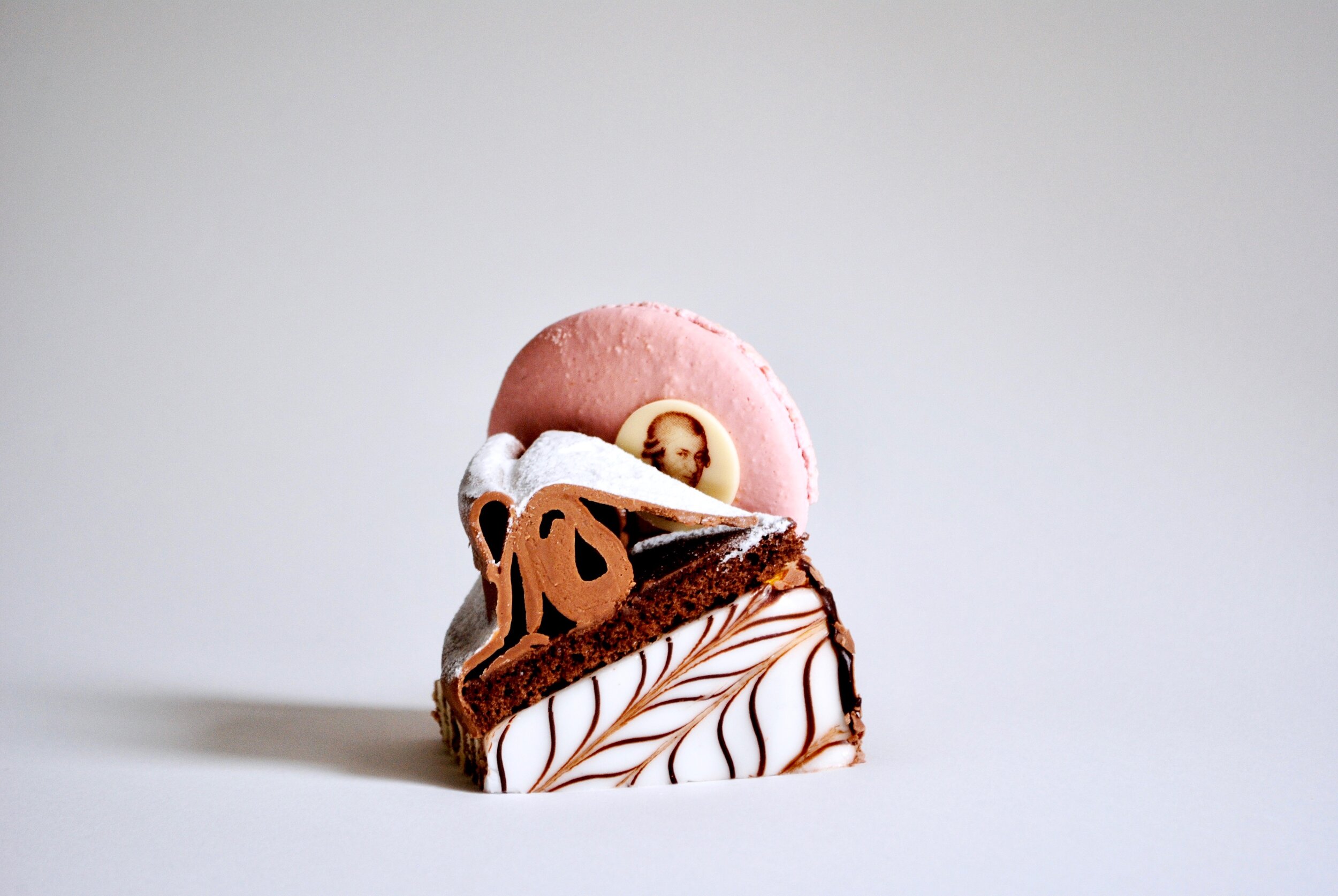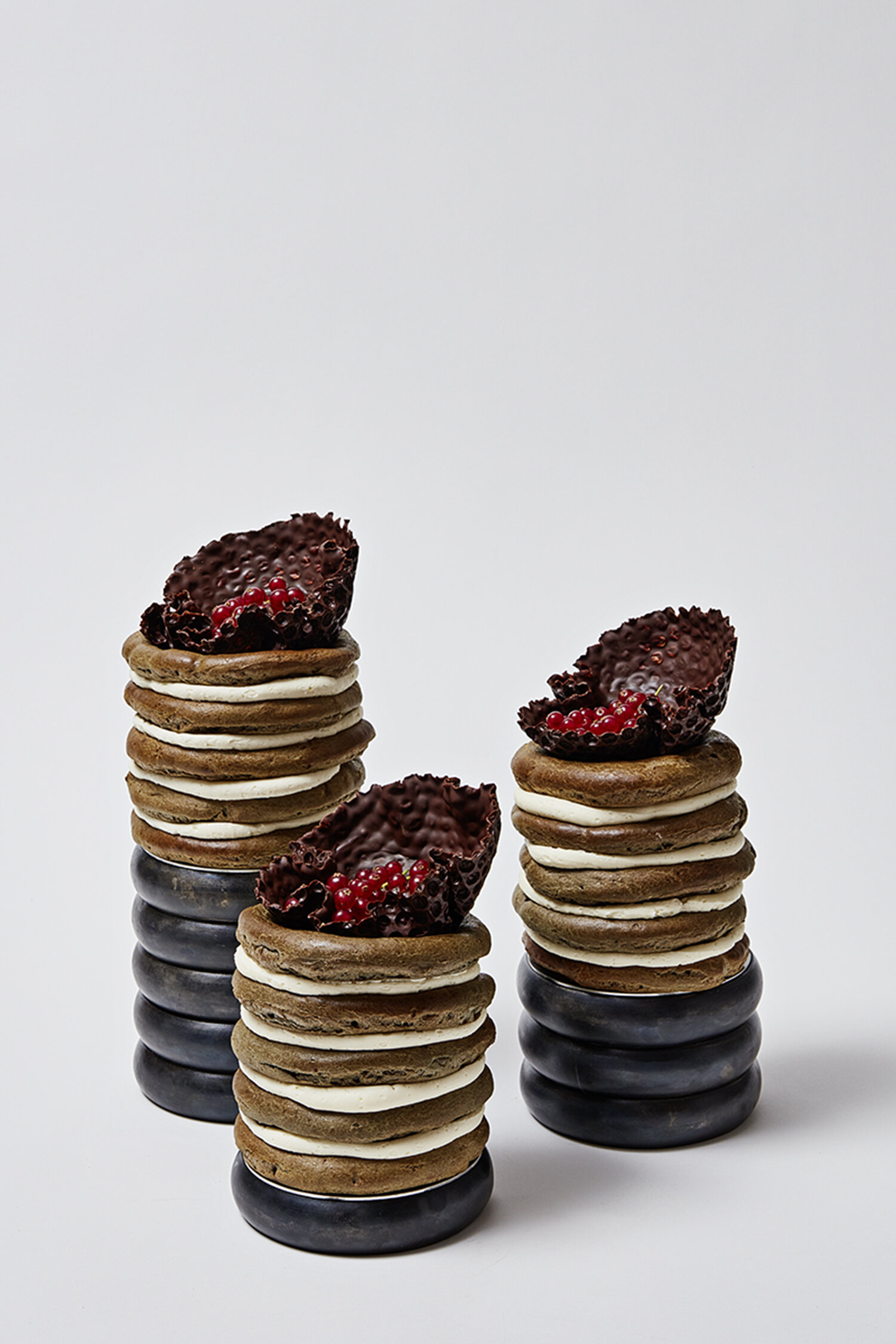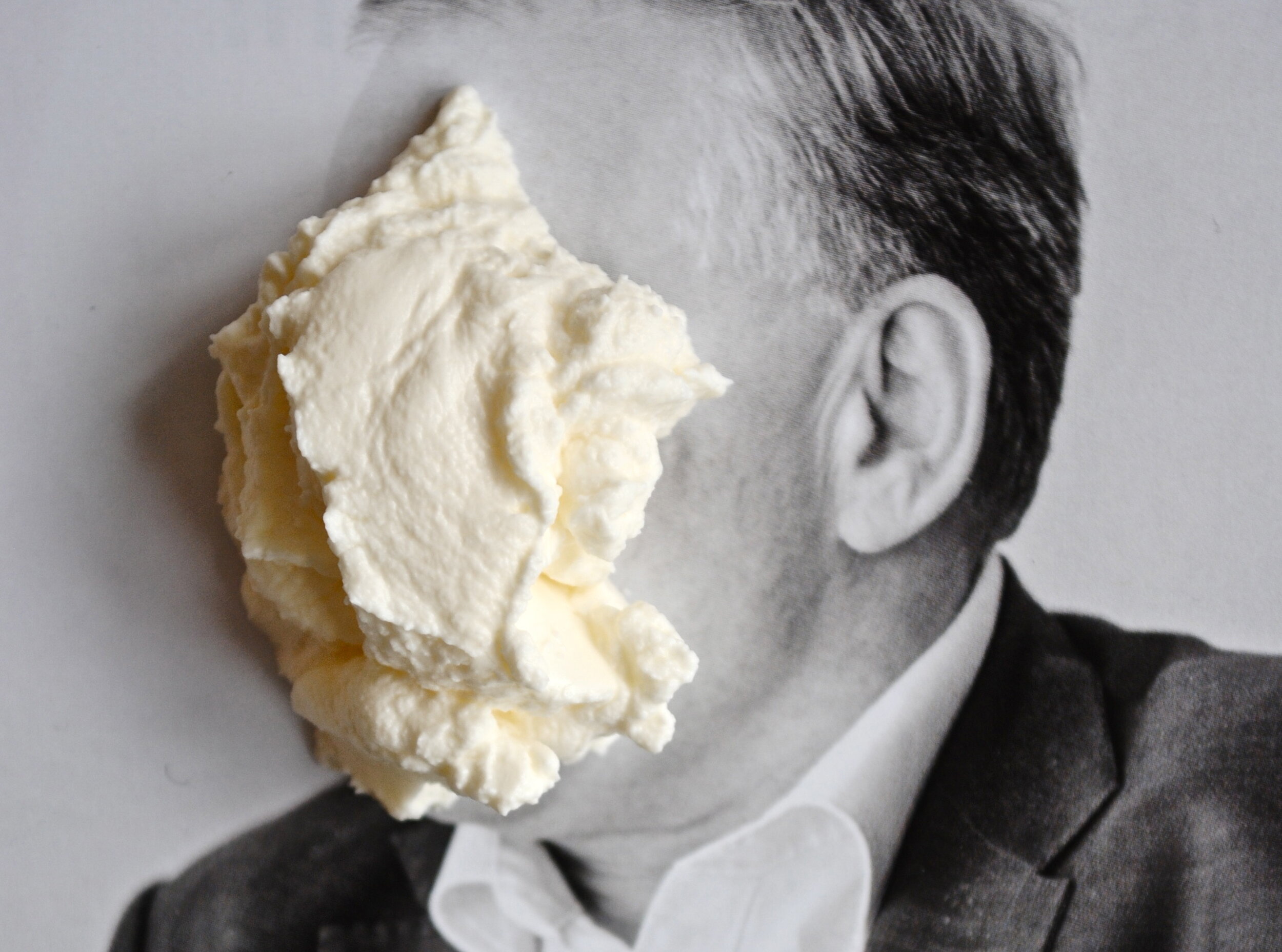Food For Thought
Interview with Orlando Lovell
by Cluster Crafts Lucy Swift
Fruth
FOOD
FOR
THOUGHT
Demel
Taking food into the sculptural realm, transcends its function into something that can not only be visually admired but can engage the audience through means of social commentary. In this way, the connection we share with food and the otherwise recognizable aspects are transformed, both a means of nutrition into a new art form, and simply put, a craft. Through delicate application of ingredients, a precise and thoughtful approach is explored. The aspect of impermanence in relation to food and the length of its life cycle can be seen in a cyclical approach where ingredients are once grown and brought to life, are very quickly consumed and brought back to the earth through composting. A beautiful environmental process this may be, however when such time and care is placed into the ‘curation’ of ingredients, it could be challenging to see that so quickly disappear; this is where the social aspects surrounding food culture comes in. Food acts as a tool to bring people together, a shared love for the ingredients consumed, it provides a place for conversation, a harmonic ‘closeness’ between two individuals, laughter shared amongst friends, each of us hold memories close to us which can be in some cases centered around food.
In ‘Food for Thought’, Cluster Crafts explores the duality of food both as a means of social connection and as a form of sculpture, captured in such a way to be experienced and shared. Here we connected with Orlando Lovell, a creative who describes herself as a “cake curator” taking ingredients, transformed and arranged in such a way they could be seen as a sculptural piece. On the fringes of my traditional forms of research and inspiration, Orlando’s work truly captivated and engaged my senses at first sight. Her practice of taking ingredients in this bold and innovative approach touches on the aspect of art and contemporary sculpture, through a medium with a function to be eaten, into a work of art providing aesthetics, and at its heart, a social and political context.
Tapping upon further research, Ines Neto dos Santos, MA RCA Graduate, explores food culture and its relationship to nature. Working on performative projects such as ‘Expedition Empathy’ carrying a sourdough starter within the land whereby “placing what surrounds us into the inside of us” linking humans to nature through food. In a collaborative project, Ines worked with Open Space Contemporary bringing food culture into the environment of an art gallery producing Tender Touches, a project of 11 artists creating each component of the space from sculptures to tableware; food culture and art became intertwined.
A project that responds to the current climate of COVID-19, is by fellow food and art appreciator, Gary Mack. His project, ‘Distanced Dining’ provides a place for meals to be shared, but from a distance; cook for four other people once a week and get four meals in return. Although in lockdown, and unable to be physically present to share a meal, ‘Distanced Dining’ provides a connected spirit, by friends each having the same meal from the comfort of their own home. One member cooks a large batch of food which is divided and sent between the group. For those missing those lovely meals shared with friends, I invite you to check out ‘Distanced Dining’, keeping loved ones connected through the realm of food.
Bill Jones Illustration - 'Distanced Dining' project by Gary Mack
Salty Studio based in London, provides innovative and sensory experiences through food from Pantone coloured drinks as an example of their inventive crossover between food as a craft. Recently, they have worked on ‘Edible Words’, an online webinar platform as a space to host discussions on food, trends, wellbeing inviting guest speakers to participate.
Cluster Crafts, is exploring the possibility of a ‘Dinner Scenario’, a dinner setting within the gallery environment, inviting previous exhibitors to produce tableware items, just as with Orlando, transforming cake into a form of art, Cluster Crafts is set to transform craft items into a dinner scenario; a place for shared conversation between creatives in an alternate gallery setting. With social distancing in place, Cluster is rethinking the possible ways such a project could unfold.
To explore Orlando’s project ‘Polycreative’, the act of sharing and connection with individuals could not be more relevant in todays society. We are emotive beings, with an innate sense for what we create, whether through food or craft to be communicated, shared and experienced. In a time when perhaps we are distanced from loved ones, we turn to projects such as these for inspiration, aesthetic appreciation and to simply broadening our horizons, that sometimes the simplest of ingredients can be transformed into something beautiful. We would like to thank Orlando for her fantastic participation in this interview, and hope it has inspired you to perhaps look at those ingredients stored away in a new light.
‘Polycreative’ explores the concept of collaboration and calls into question what the term ‘creative relationship’ constitutes. In uncertain times due to the climate crisis of COVID-19, what is your view on the importance of collaboration?
Polycreative Ritual I | Photography Christoph Sagel
In my project Polycreative, I not only explored collaboration with multiple others and the resulting questions of ownership and shared creative process and outcome; I also worked with people I had never met, or could only be in touch with through digital means. From Bertille Laguet, the blacksmith designer in Switzerland, whom I have not met to this day, but spoke with about every step of her process via a chat service, to Buster Stroucken the ceramic artist in Amsterdam, whom I video chatted with once and then didn't hear from for a few weeks, until he turned up on my doorstep in Berlin one night with a stunning ceramic surprise. Polycreative is all about having trust that collaboration can take place across distances, as well as the trust that by giving each creative space to develop on their own, they will be able to pass on their output for others to build upon. Looking back, I see that in a way, Polycreative was a rehearsal for the current times we find ourselves in.
Polycreative Ritual I | Credits | Photography Christoph Sagel
Many of your works, particularly ‘Polycreative’ explores themes of communication and moments of experience. In a very digital oriented society and with a lack of human interaction; how can we utilise what we have to offer effective communication?
Those of us lucky enough to have a good internet connection can rely on a cornucopia of digital communication tools. Sometimes an "old-school" phone call can answer more questions than a whole bunch of text messages. Or even a handwritten letter! I think a balance of different modes of communication is key. You need to find what works for you and the person you are trying to reach. Constantly texting someone who doesn't like to type will probably be a frustrating experience for both parties. For Polycreative I used video messaging, direct text messaging, photo sharing and email. In the end, the best medium for me to express my gratitude to all the participants for their time and effort was to write them all letters, attaching a final print of the work we’d made together, wrapped in silk paper. This way, communication also became about investing time to give back and being appreciative.
Polycreative Ritual II | Photography Christoph Sagel
Polycreative Ritual II | Credits | Photography Christoph Sagel
Polycreative Ritual III | Credits | Photography Christoph Sagel
Polycreative Ritual III | Photography Christoph Sagel
In times of social distancing and isolation amongst individuals, what inspires you during this time?
I am inspired by the compassion and kindness I am currently experiencing. I grew up in the centre of Berlin, a stone-throw from the well known "Alexanderplatz". Over time this space has become a hectic hub for consumerism and tourism. The last weeks have felt so gentle, it has become very quiet here and those that do wander out do so tentatively, giving space and checking in with strangers they encounter, even if it’s just by making eye contact while maintaining physical distance. My feeling is that people care more when they have time to.
Polycreative Ritual V | Photography Christoph Sagel
Polycreative Ritual V | Photography Christoph Sagel
In what way do you feel the climate crisis of COVID-19 may have affected art and design practices? What positives do you feel may come out of this time? Is your creative practice at all affected by the pandemic?
Nothing has changed for me, creatively. The same exhibitions and projects are still due to happen, just postponed until we can come together again in the same space to continue our practice. But I don’t feel compelled to exploit the current situation or squeeze it for its creative potential. After years of studying and working to build my practice, I feel confident in carrying on with my work in a way that makes sense for all involved but without shifting everything I do to be "on trend".
Food for Thought
Mixing the medium of collage with fresh food, I aimed to create different atmospheres and situations using found portrait images to explore mixed emotions relating to food.
Your work with Manchester University and your involvement with creative education calls into question the methods of teaching creativity. During a time when many universities have been affected by COVID-19; what are your thoughts on how creative courses are currently taught and will this need to change? Do you think universities and institutions may need to change the way the current curriculum is being taught?
I think the education crisis existed long before. Already in my creative education, there was a divide between creating and learning from online tutorials. The role of a tutor has become unclear, as many creatives today work in so many different mediums that no one teacher can master them all; the teacher must therefore either restrict their students to only producing what they can judge and teach, or let their students create and educate themselves, becoming thereby more of a moral or stylistic compass. These questions hold regardless of physical encounter. For my studies I travelled a lot, I spent some time in Milan, a few months in Paris, a year in Basel, my last half year in Berlin, and all the while I was officially studying in Eindhoven in The Netherlands. Creating my own educational pathway was my greatest take-away from that time.
What sparked your interest to develop and convey ideas around social and political emotional questions?
Social, political and emotional are the three words I would use to summarise my experience working with medium of cake. There are many lenses through which to observe people's interaction with the material. These are always interconnected and can be seen on small or larger scales, but personal emotion inevitably informs our social behaviour and therefore our political orientation. If you choose to see each facet in isolation, you end up misunderstanding the whole system. This is what I try to communicate with cake: the initial response is personal and emotional, the secondary is social and sharing, which can open up a conversation that goes beyond the table and looks at our political environment, scaled up from our social and emotional decisions.
What does the future hold for you and your practice?
I am currently working with a start up in Berlin on a project for the food industry, which is allowing me to have insight into a much bigger system, as well as the individual people behind it. I am continuing my exploration of cake as a medium in different cities and cultures in the form of exhibitions and hope to be part of a project in Istanbul about Turkish pastry culture, as well as an exhibition about Polysensuality in Berlin.
Thank you for reading,
Lucy Swift








